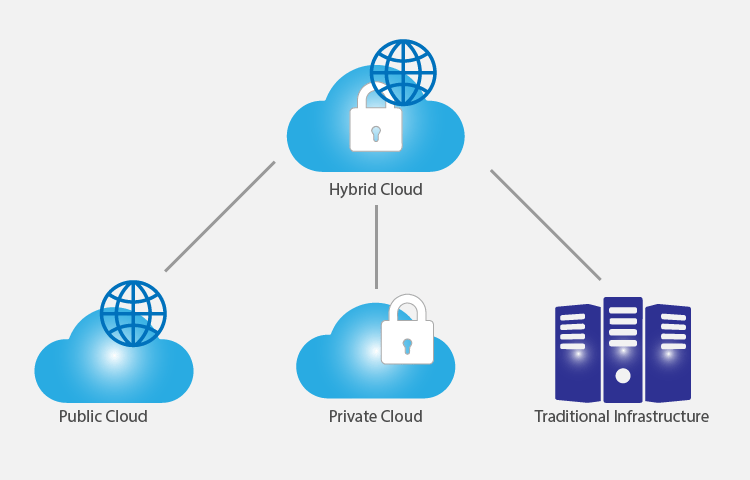Hybrid Cloud Solutions: Bridging On-Premises and Cloud Environments
Introduction
In today’s dynamic business landscape, organizations are increasingly adopting hybrid cloud solutions to leverage the benefits of both on-premises infrastructure and cloud environments. This strategic approach offers flexibility, scalability, and agility while maximizing control, security, and cost-effectiveness. In this blog, we’ll explore the concept of hybrid cloud solutions, their advantages, key considerations, and best practices for seamless integration.
Understanding Hybrid Cloud Solutions
Hybrid cloud solutions combine on-premises infrastructure with public and/or private cloud services, allowing organizations to optimize workload placement, resource utilization, and data management. By leveraging a hybrid approach, businesses can achieve a balance between the scalability and agility of the cloud and the control and security of on-premises infrastructure.
Advantages of Hybrid Cloud Solutions
- Flexibility and Scalability: Hybrid cloud solutions enable organizations to scale resources up or down based on demand, leveraging the elasticity of the cloud while maintaining critical workloads on-premises.
- Cost Optimization: By selectively migrating workloads to the cloud and retaining others on-premises, organizations can optimize costs by matching workload requirements with the most cost-effective infrastructure.
- Security and Compliance: Hybrid cloud solutions allow organizations to maintain control over sensitive data and critical workloads on-premises while leveraging cloud security measures and compliance frameworks for other workloads.
- Disaster Recovery and Business Continuity: By replicating data and workloads across on-premises and cloud environments, organizations can ensure resilience and continuity in the event of disasters or disruptions.
Key Considerations for Implementing Hybrid Cloud Solutions
- Workload Assessment and Planning: Conduct a comprehensive assessment of workloads to determine their suitability for migration to the cloud or retention on-premises.
- Data Management and Integration: Develop robust data management and integration strategies to ensure seamless data flow and consistency across hybrid environments.
- Security and Compliance: Implement security controls, encryption mechanisms, and compliance frameworks to protect data and ensure regulatory compliance across hybrid cloud environments.
- Performance Monitoring and Optimization: Establish performance monitoring tools and processes to track workload performance and optimize resource utilization across hybrid environments.
- Vendor Selection and Integration: Choose cloud providers and technology partners that offer seamless integration with on-premises infrastructure and align with your organization’s goals and requirements.
Mastering Cloud Cost Optimization: 5 Best Practices for Azure, AWS & GCP
Best Practices for Seamless Integration
- Establish a unified management and orchestration framework for managing resources across hybrid environments.
- Implement robust network connectivity and security controls to ensure seamless communication and data protection between on-premises and cloud environments.
- Leverage automation and DevOps practices to streamline provisioning, deployment, and management of workloads across hybrid environments.
- Foster collaboration and communication between IT teams responsible for on-premises infrastructure and cloud operations to ensure alignment and synergy in hybrid cloud management.
Here are some pieces of information from the Top 3 Cloud Providers:
Conclusion
Hybrid cloud solutions offer a strategic approach to IT infrastructure management, enabling organizations to harness the benefits of both on-premises and cloud environments while addressing specific business requirements and challenges. By adopting hybrid cloud solutions, organizations can achieve greater flexibility, scalability, security, and cost-effectiveness, positioning themselves for success in today’s digital economy.
Transform your IT infrastructure with hybrid cloud solutions, maximizing scalability, security, and cost-effectiveness while seamlessly bridging on-premises and cloud environments.
Empower your organization with the flexibility and agility of hybrid cloud solutions, balancing the benefits of on-premises control with the scalability of the cloud. Navigate key considerations such as workload assessment, data management, and security to ensure a seamless integration process. With robust performance monitoring and optimization strategies, achieve unparalleled efficiency and resource utilization across hybrid environments. Stay ahead in today’s digital landscape by leveraging the power of hybrid cloud solutions to drive innovation, resilience, and business growth. Let our guide be your roadmap to unlocking the full potential of hybrid cloud technology for your organization’s success.
- Why should you automate Active Directory cleanup? - 17 June 2025
- Troubleshooting: Unable to Add Instance Failover Group to Azure SQL Managed Instance - 4 March 2025
- 10 Azure Virtual Desktop (AVD) Cost-Optimization Strategies for 2025 💡💰 - 22 February 2025


